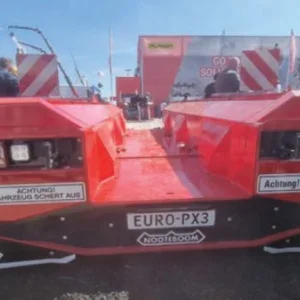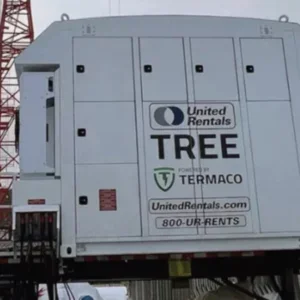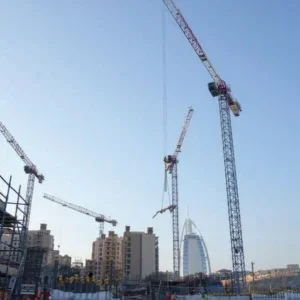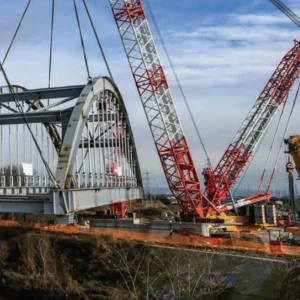Georg Diesch, president of Liebherr Cranes Inc., Newport News, Virginia, says that he would range overall demand for cranes across the country as between steady and low with a certain tendency for customers to be looking for used cranes, and demand for larger cranes remaining acceptable.
Ernesto Uriegas, director of cranes for Terex Latin America, says weakness in the crane market is attributable to fear and a lack of confidence in the current economy, with construction product activity expectations “low and feeble”.
Helping to feed this situation is the fact that, while overall unemployment in the United States is at about 10%, unemployment in the construction industry is closer to 20%, according to Brax Snyder,manager of worldwide sales for Link-Belt Construction Equipment Co., Lexington, Kentucky.
In addition the credit crunch has had a strong impact on many new crane deals, Diesch observes. “Tighter lending principles have forced many buyers to hold off on buying equipment. In addition, increased security requirements, as well as higher interest rates, have made the loans dearer for them than they had been used to in the past. Moreover, equipment has been devalued in many cases leading to higher down payments or the need for additional collateral.”
Snyder observes that a lot of business in the wind energy, road and bridge construction markets is currently very slow, largely because of a lack of availability of funding for those kinds of jobs. “Banks continue to be very selective about who they are lending to,” he says, noting that ‘A’ type businesses might be able to get financing, but ‘B’ and ‘C’ businesses are still having a hard time.
“It isn’t just that banks won’t loan money, people don’t want to take the risk of getting a loan,” says Mike Appling, president of TNT Crane, Houston. “They probably took too much risk in the past. Now they want to deleverage their balance sheets given the uncertainty in the market.”
The funding issue is easing somewhat, says Jason Walton, marketing manager for Essex Crane Rental Corp., Buffalo Grove, Illinois. “It is easing a little, but not as much as we would like. It will be a lot clearer in the second quarter. We will have a better idea where the construction market will be then. Right now there is a lot of ambiguity.”
But while there is no doubt that business there could be better, it is generally believed that demand for new, used and rental cranes in the Gulf of Mexico region is somewhat better than other regions in the United States. “Refineries are a driving force and the stabilising oil price is a big plus in this scenario,” says Diesch. “In addition, even commercial work is steady.”
“There has been a pickup in demand for lattice crawlers and truck cranes and to a less degree rough terrain cranes,” says Curley Bordelon, sales manager for Scott Equipment Co., Monroe, Los Angeles. “It won’t set the world on fire, but it is better than it has been.”
The economic downturn has resulted in a number of rental companies coming to Houston to find a home for their fleets, says Jack Fendrick, vice president of Kobelco Cranes North America. “The refineries always need cranes. The rental companies come here when times are tough elsewhere.”
Allen Richie, president of Bado Equipment Service Co., Houston, says that this is probably the slowest rental period in many years. “I don’t know if everyone is just scared about the economy,” he says, noting that his company had been busy right through the fourth quarter. “But it has been slow for the last four months.”
He says that he is seeing about a 50% decline in rental business year-on-year, “and it is anyone’s guess what will happen in 2010.
“My gut feeling is that we have seen the worst of it and that we are near a pickup. We need to ride out the economy to see what happens. We should have some sizable construction projects coming up, especially if the oil and natural gas and petrochemical industries pick up.”
“With the downturn you would expect a resurgence in renting, but we aren’t seeing that much,” observes Bill O’Rourke, Essex’s vice president of sales. Walton says that might be offset by the fact that crane selling prices have dropped with people selling more used cranes.
Uriegas agrees: “Currently we are seeing a flourishing market for used cranes. They are supplied by the rental companies and many construction companies want to take advantage of the lower acquisition costs,” he says.
The general impression of industry participants is that the percentage age of rentals to purchased cranes has not changed all that much. “Rental company business is important to us as they purchase a number of large cranes for their fleets,” Snyder says, observing that about 75% of all telescopic cranes and 50% of crawlers start in a rental fleet.
“The Gulf of Mexico is known for its industrial business,” says John Bockway, vice president of crane sales for H&E Equipment Services, Baton Rouge, Louisiana. “There is always business, at least maintenance work.”
“Houston is a big market for construction cranes year in and year out,” says Snyder, and this year is no exception, with the need for cranes for refinery work continuing. Much of that, however, is for maintenance and repair work. Currently there aren’t many new refineries or refinery expansion projects on the books.
The oil refining industry, as well as the oil and natural gas industry in general, had been hit bad last year when oil prices dropped from USD150 a barrel to below USD50. That, combined with the current air of uncertainty as to what the nation’s energy policy will be, has caused the refinery industry to just about come to a halt. “But it isn’t completely down,” says O’Rourke, who observes that some big projects are starting to be revived. One notable example is a Shell joint venture refinery expansion project with Motiva Enterprises in Port Arthur, Texas, which was put on hold last year and is now starting to be released for work.
Appling says that the refinery industry had enough cranes when times were great and now has an over abundance as there has since been some bankruptcies. “Now that the energy market is coming back there is some activity. Orders are up 10-15% from a very ugly level.”
One motivating factor has been a recent pickup in both the US and the Gulf of Mexico drill rig count as reported by Houston-based energy services company Baker Hughes Inc., spurred by the fact that oil prices have climbed back to USD70-USD80 a barrel, which, according to Gene Shiels, Baker Hughes’ assistant director of investor relations, is now high enough to make drilling economical.
Over the last several weeks, the US drill rig count has risen each week to 1,317 drill rigs at the end of January, up 2.7% from 1,282 rigs the previous week but down 10.5% from a year earlier. The number of US rigs had peaked in September 2008 at about 2,014 rigs and then fell to 875 rigs in June 2009. It has been increasing fairly consistently since then.
The number of rigs in the Gulf of Mexico have held steady at 41 throughout January, which, while being down 30.5% from 59 rigs a year earlier, is up 41.4% from the low point of 29 rigs in August 2009. Shiels says it isn’t clear what will happen the rest of the year in the Gulf, “but I think we could see modest increases as we go forward, especially on the deep water side.”
Bado’s Richie says that even though some rigs have gone back to work recently, there continues to be a glut or rigs sitting idle. “We are seeing some signs of improvement, but it is still very slow.”
“The oil industry has been a driving force in the Gulf of Mexico region and we will continue to see its impact in the future,” says Terex’s Uriegas.
“But in the Veracruz area we are also seeing wind power projects. This will modify crane usage (including rough terrain and crawler cranes) in the Gulf of Mexico in following years.”
Bordelon says there has also been demand for cranes used in connection with natural gas drilling on leased properties. “That had been slowing, but is starting to pickup,” he says. Most of the recent pickup in natural gas drilling nationwide has been due to the increased amount of horizontal drilling in unconventional gas plays, says Baker Hughes’ Shiels. This includes Texas’ Barnett shale play, as well as the Williston Basin, Bakken and Marcellus shale plays outside of the Gulf of Mexico region.
Shiels observes that McMoRan Exploration Co.’s recently discovered Davy Jones ultra-deep prospect in the Gulf’s shelf holds some great potential.
“We are seeing some increase in the petrochemical and plastics industries,” says O’Rourke. Nationwide, according to Martha Gilchrist Moore, senior director of policy analysis and economics for the American Chemistry Council, Arlington, Virginia, US production of chemicals excluding pharmaceuticals is expected to be up about 3% in 2010, 3.3% in 2011 and 3.4% in 2012 after falling 6.2% in 2009. Petrochemicals, which accounts for 31.7% of all chemical production, will lead the way with a 5.2% increase in 2010.
According to Kobelco’s Fendrick, 90% of refinery and chemical plant business is in the Gulf of Mexico region.
“The reconstruction of the Gulf region, not just Louisiana, but also Mississippi and Alabama, will maintain its current elevated level for a while,” says Link-Belt’s Snyder. “That is one of the brighter spots for us as far as equipment sales, especially for crawler cranes,” he says. He also notes that following Hurricane Katrina there has been a lot of flood wall and pumping station work, as well as a refinery refurbishing and upgrades and, “that will continue for a while as there is no quick fix there”.
H&E’s Bockway observes that funding issues had held things back for a while but now more work is being generated in Louisiana and elsewhere on the Gulf Coast. O’Rourke adds: “The Army Corps of Engineers is finalising their designs for New Orleans nearly five years after Hurricane Katrina. We have been very frustrated at the continued delays, but we are finally starting to see final designs, which lead me to believe that some crane orders are imminent.”
The credit crunch is not affecting the rebuilding efforts in New Orleans and elsewhere on the Gulf Coast, as well as refinery work, Snyder says. “There is a lot of political importance to the rebuilding of New Orleans, so that isn’t being stalled by the credit situation. Also the credit crunch isn’t having much of an effect with refinery work. Most oil companies have enough money internally to fund the work they need to do. They don’t have to borrow it.”
Most fabricators’ and shipbuilders’ business in the Gulf is currently subdued, and condominium development and gaming and entertainment projects are largely on hold, says O’Rourke. In some cases inquiries are picking up, but there are no new orders as yet, he says.
A lot of the uncertainty in the market right now, Diesch says, revolves around how much stimulus money will go toward projects. “Lots of projects are ready to go but just waiting to get funded,” he says. O’Rourke says that there has been a small amount of stimulus money trickling down for certain projects, “but it is few and far between, and it takes a while to filter down to crane suppliers.”
Diesch says that companies aren’t largely overexcited about what to expect in 2010. Fendrick says: “I don’t think that the market will turn the corner until 2011.” O’Rourke agrees, stating: “The good news is that the drag of 2009 seems to be over.”






